Episode 170
What you’ll learn in this episode:
- Why designing a bracelet is the same as designing a bridge
- Why jewelry has its own design language, separate from the language of fine art or craft
- How Warren learned about the engineering of jewelry making by doing repairs
- Why the architecture of a piece of jewelry is as important as its visual design
- Warren’s tips for creating beaded jewelry that will withstand the stress of movement
About Warren Feld
For Warren Feld, beading and jewelry making endeavors have been wonderful adventures. These adventures over the past 32 years have taken Warren from the basics of bead stringing and bead weaving, to wire working and silver smithing, and onward to more complex jewelry designs which build on the strengths of a full range of technical skills and experiences.
He, along with his partner Jayden Alfre Jones, opened a small bead shop in downtown Nashville, Tennessee, about 30 years ago, called Land of Odds. Over time, Land of Odds evolved into a successful internet business. In the late 1990s, Jayden and Warren opened another brick-and-mortar bead store – Be Dazzled Beads – in a trendy neighborhood of Nashville. Together both businesses supply beaders and jewelry artists with all the supplies and parts they need to make beautiful pieces of wearable art.
In 2000, Warren founded The Center For Beadwork & Jewelry Arts (CBJA). CBJA is an educational program, associated with Be Dazzled Beads, for beaders and jewelry makers. The program approaches education from a design perspective. There is a strong focus on skills development, showing students how to make better choices when selecting beads, parts and stringing materials, and teaching them how to bring these together into a beautiful, yet functional, piece of jewelry.
Warren is the author of two books, “So You Want to Be a Jewelry Designer: Merging Your Voice with Form” and “Pearl Knotting…Warren’s Way,” as well as many articles for Art Jewelry Forum.
Additional Links:
Warren Feld Jewelry
www.warrenfeldjewelry.com
Warren Feld – Medium.com
https://warren-29626.medium.com/
So You Want To Be A Jewelry Designer School on Teachable.com
https://so-you-want-to-be-a-jewelry-designer.teachable.com/
Learn To Bead Blog
https://blog.landofodds.com
The Ugly Necklace Contest – Archives
http://www.warrenfeldjewelry.com/wfjuglynecklace.htm
Land of Odds
www.landofodds.com
Warren Feld – Facebook
www.facebook.com/warren.feld
Warren Feld – LinkedIn
www.linkedin.com/in/warren-feld-jewelrydesigner/
Warren Feld – Instagram
www.instagram.com/warrenfeld/
Warren Feld – Twitter
https://twitter.com/LandofOdds
Photos:
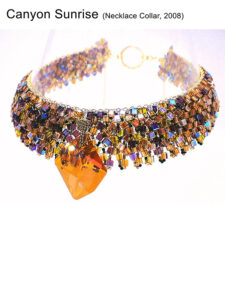
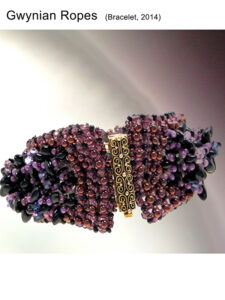
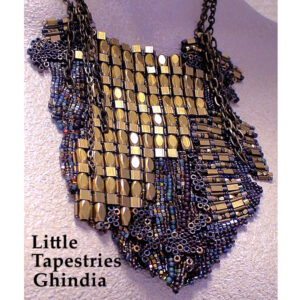
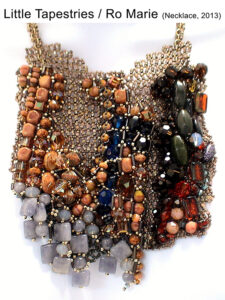
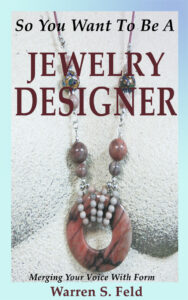
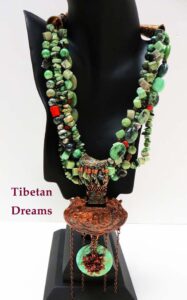
Transcript:
Warren Feld didn’t become a jewelry designer out of passion, but out of necessity. He and his partner Jayden opened their jewelry studio and supply store, Land of Odds/Be Dazzled Beads, due to financial worries. But coming to the world of jewelry as an outsider is what has given Warren his precise and unique perspective on how jewelry should be made. He joined the Jewelry Journey Podcast to talk about the language of jewelry design; why jewelry making should be considered a profession outside of art or craft; and why jewelry design is similar to architecture or engineering. Read the episode transcript here.
Sharon: Hello, everyone. Welcome to the Jewelry Journey Podcast. This is a two-part Jewelry Journey Podcast. Please make sure you subscribe so you can hear part two as soon as it comes out later this week.
Today, my guest is jewelry designer Warren Feld. Warren wears several hats. He has an online company called Land of Odds. He has a brick-and-mortar store, Be Dazzled Beads, and he’s a jewelry designer. He’s located in Tennessee. He has been a jewelry designer for decades and has written a book called “So You Want to Be a Jewelry Designer,” which sounds very interesting. The book sets up a system to evaluate jewelry and discusses how designing jewelry is different from creating crafts or being an artist. Warren will tell us all about his jewelry journey today. Warren, welcome to the program.
Warren: Sharon, I’m so excited to be here with you.
Sharon: So glad to have you. Tell us about your jewelry journey. Were you artistic as a child? Did you study jewelry? How did you come to it?
Warren: I think I was artistic as a child, but my parents and teachers, my guidance counselors in high school, discouraged it. They put me on a track to be either a doctor or a lawyer, so I never had artistic training. In my thirties, I got into painting with acrylics. Not in a deep way, but in some artistic way. I never formally studied art. I became a health care administrator, and I was a professional hospital administrator at several hospitals. I was a policy planner in healthcare for the governor of Tennessee. I was director of a nonprofit healthcare agency. When I was around 35, I experienced a major burnout. I didn’t like healthcare and I felt very disconnected. I was doing a great job, but I just didn’t feel it.
At the same time, I met my future partner and wife, Jayden. It was a recession, and Jayden was having trouble finding a job. At one point I said, “What can you do?” and she said, “I can design jewelry,” and I said, “We can build a business around it.” I thought it would also be a good idea to sell the parts, and it worked. We first had a garage sale, where she made a lot of jewelry and sold a lot of parts, and we made $7,000. Maybe it was a fluke. So, six weeks later, we tried it again. We made the same jewelry, got the same parts, and made $4,000. So, we thought we were onto something. We eventually did the Nashville Flea Market and craft shows. We had a little store in downtown Nashville. We have a bigger store in downtown Nashville now. It worked. It was really around her jewelry designing and my business sense. I made some jewelry, but it was just to make money.
Sharon: Wow! So, you have two businesses. You have an online business, and you have the brick-and-mortar. Tell us about Land of Odds and Be Dazzled Beads. Tell us about the differences.
Warren: Originally it was Land of Odds. Jayden was the designer. We made jewelry, but it was more like I put a bead on a piece of leather and tied it in a knot. Eventually I started learning. While working at learning silversmithing, I did a lot more complex things, but she was the designer. She had country music artist clients and did a lot of custom work. The first few years, I really made jewelry just to make money. I didn’t see it as an art form. It wasn’t my passion. I wasn’t interested, but one thing I noticed was that everything I made broke. It was really bad, and I was clueless. This was in 1987. There was no internet, no jewelry or bead magazines. Nashville did not have a jewelry-making culture, so everything was trial and error, things on fishing lines, things on dental floss. I didn’t know how to attach a clasp, didn’t know about clasps. Everything was so trial and error, experimental.
At some point, I started taking in repairs. That was a really strategic move and a major turning point, because I got to see how other people made things and made bad choices because of what broke. I got to talk to the wearers, and they told me how they wore it, what happened when it broke, where it broke, lots of inside stories. I started formulating some things, and I started putting them to the test and making jewelry. I was in my mid-to-late thirties, and I started getting interested and focused on the construction and the architecture, not quite the art form. Jayden’s health also declined. She lost a lot of dexterity in her hands to be able to keep making jewelry. She retired, and I started making the jewelry and doing the custom work. The business started getting organized around my work. That was Lands of Odds. We were downtown in Nashville.
Sharon: At Be Dazzled Beads, you teach a lot of classes. You sell beads. You do everything.
Warren: It just evolved. It had to do with the fact that we were downtown. Nashville, at the time, was what Greenwich Village in New York was. It’s a lot of little specialty shops, a lot of excitement. It was really high-end, very sophisticated. It was so successful that the big companies started moving in, Hard Rock Café, Planet Hollywood, Nascar Café, Wildhorse Saloon. When the city decided to redevelop the area for them, they took away 6,000 parking spaces in 18 months, and parking went from $2 to $20 a day. We lost all our customers really fast, and tourists changed. They were looking for low-end souvenirs, not high-end jewelry, so our business collapsed.
We put ourselves in Chapter 11 bankruptcy, and the liability is under my name. I closed Land of Odds, the physical store, and I put the assets under Jayden’s name. We opened a little shop in a little house, and Jayden wanted to call it Be Dazzled. At the same time, I was developing Land of Odds as an online business. Be Dazzled was a real place in a store. About a year after declaring bankruptcy, I got out of bankruptcy and the catalogue took off. We were doing really well all of a sudden, and I combined both businesses again. So, I just had this horrible business name, Land of Odds/Be Dazzled Beads. We managed those as two separate businesses, but it was really one business.
Sharon: So, you were online way before Covid or anything.
Warren: I was online in 1995. I was one of the first catalogues online. We’re still online. It’s a little hard to compete today online, but we’re still online.
Sharon: That’s interesting because so many jewelers are not. You call yourself a jeweler. I don’t mean you’re not a jeweler; you are, but they don’t work with beads. They work with silver; they work with gold. So, it’s unusual.
Warren: No matter what the materials, you end up with something with a hole in it or a loop on it so you can string it on or dangle it. I taught myself wire working, fiber art, micro/macro maze, silversmithing. Even though the tools are different, the materials are different, when you’re designing a piece of jewelry, you end up thinking through the same kinds of issues. The focus on parts was another lucky break because it made me realize early on that jewelry design was quite different than art or craft.
I started as a painter. When I first started making jewelry, I tried to paint it. I was very frustrated because I couldn’t get the colors I wanted. You can’t squish the beads together; you can’t do little nuances and subtleties like you can do with paint. There are these annoying gaps of light, negatives spaces you can’t control, and they destroy the whole idea of color. You have three-dimensional objects that reflect and refract light differently. It changes from room to room with lighting, the sun, the position of the person, how they’re moving. I have some beads in the store, green, transparent beads that cast a yellow shadow. You can’t duplicate that with paint, but you have to worry about if the jewelry starts to look weird on a person because you picked the wrong materials or the wrong colors. Jewelry applies to the person wearing it. You don’t want that to happen as a designer.
So, I realized that whether it’s beads or string materials, findings, whatever you’re using, they assert their needs within the piece of jewelry. It’s not just for the visual grammar, the color and pattern and texture, but they have needs for architecture. They affect some of the functions based on materials you pick, and the durability and how the piece moves. They affect the desirability and the value, how people perceive the piece. So, I began to see that I had to start with the parts and understand how they want to be expressed within a three-dimensional object that’s going to adorn someone’s body and move and meet someone’s psychological and social needs. It’s very focused on the parts.
What I was doing as a jewelry designer was very different than what I had done as a painter, as an artist. The lights went on, and it just was really intriguing. I struggled and dealt with it. It was very exciting and enjoyable to figure out, with that green bead that has the yellow shadow, what effect does it have on the piece, on the person wearing it, on people seeing it? I asked those questions, and that was really important. I was lucky to start with the parts and the business and not start with just designing jewelry and worrying about the visual grammar. Then I realized, both from being in business as well as teaching students, that most jewelry designers are very naïve to the impact of the parts. They’re very focused on the visual, the color. They don’t realize that so much more is going on in a piece of jewelry, so they don’t think about managing it.
Sharon: So that’s how you came to write this book, “So You Want to be a Jewelry Designer”?
Warren: Right.
Sharon: Wow! Being a painter and working in different materials, you’re all over the place.
Warren: I had been thinking about or trying to write this book for at least 20 years. Having all these insights, I wanted to write them down. I would write them down in these articles, sometimes fun articles and sometimes very straightforward, more academic articles, and I struggled with how to pull this all together. I was getting ideas about what was important. One of my goals is to say that a jewelry designer is not an occupation. It’s not a substantive art. It’s really a profession. It has its own discipline, its own way of thinking and writing and doing and asking questions, solving problems. It’s a profession, but how do I make it that way? I’ve worked that way pretty much on principle.
At one point, an education professor in town said that I might be interested in ideas about literacy and how you teach literacy to students. While I was researching that, I came across the idea of disciplinary literacy. This is an example of how a historian has to think very differently than a scientist. They use different evidence. The historian has to infer from different pieces of writing and histories and costuming to come up with an idea about cause and effect. A scientist has this rational, step-by-step approach for coming up with an idea of cause and effect. They think differently. They use different evidence. I thought, “Well, that sounds like me as a jewelry designer. I think differently than artists.” I’ve had to think differently than artists because as an artist, my designs weren’t successful.
That was the organizing principle, disciplinary literary. So then, what does it mean? What does someone have to know if they have to comprehend it? When you say someone’s fluent in design, what does that mean? How do you believe it’s real? What’s nice was that I had done all this writing, and everything started clicking into place. The organizing principle wasn’t as much of a struggle as it was to try to put it together as an idea of you need to learn A, B and C.
You need to learn about design elements and how to decode them, but in a way like you’re learning how to read them or write them or speak them. You have color. You can put colors together and create a sense of movement, another design element. Color is very independent, but movement depends on your positioning of color or line or whatever to get a sense of movement as a design element. So, here we have independent and dependent variables, vowels or consonants. Some of the design elements sounded like vowels and some sounded like consonants. How do you put it together? I realized you could put together a couple of design elements, like a T and an H in word, and you could know that E will work next. Another element or one of its attributes might work next, but a Z won’t work. THZ doesn’t work. That happens with design elements when you’re trying to put them together. When you understand design elements as sort of an alphabet, then you begin to formulate meaning and expression and words, and the words can get more and more complex.
So, you realize you’re talking about composition. You’re arranging design elements, and you have to arrange them in a way that they can be constructed together, which is another element. Then you want to manipulate them because you want to control as best as you can someone’s reaction to it. You want them to like it, to want to wear it, to want to buy it. This is all controlling meanings, as you’re taking something universal, where everyone knows what they mean. A certain color scheme, everyone knows it’s satisfying, but a simple color scheme in jewelry might be boring. It might be monotonous or it might not fit the context. It might not show power or sexuality or compliance, whatever you’re trying to do with your jewelry. You have to change that scheme a little bit, perhaps color it differently.
So, I’m going through these ideas and working them together with literacy. You want someone to be able to identify problems, identify solutions. You want them to understand how to bring all these elements and arrangements together in a certain kind of form, sometimes with a theme. And towards what end? You have to have an end. I struggled with this. What’s the end? What the jewelry is trying to get to, is it the same as an artist? And it’s not. In art, it’s about harmony with a little variety. In jewelry design, that could be monotonous, not exciting enough. In jewelry design, you want the piece to go beyond evoking an emotional response. You want it to resonate, excite, be just a little bit edgy so people want to touch it or wear it or buy it. They don’t just want to say it’s beautiful. You want to bring them the piece of jewelry so they actually will put it on, keep it on, cherish it, show it around, collect it. It has to do something more than an art. In the end, it has to do partly with how it resonates.
It seems to have more levels to it. It has to feel finished, and in order to feel finished, it has to be parsimonious. In art, there’s a concept called economy. You use the fewest colors to achieve your balanced end, but it’s very focused on the visual. In parsimony, you focus on every aspect of design, from the visual to the architectural and textual to the psychological. Parsimony means you can’t add or subtract one piece without making it worse. You’ve reached some kind of optimal set of all the design elements, all the understandings of other people that you’re bringing into the piece, all your understandings that you’re imposing on the piece. If it’s parsimonious, it feels finished, and that’s a success. So, you go a little bit beyond what an artist does for your piece of jewelry.
Sharon: Are these different in craft? I’m sorry; that’s what I’m trying to understand. Are they different in craft or fine arts?
Warren: In craft, your goal is to end up with something. Ideally, it should have some appeal, but it’s got to be functional. You just end up with something. In art, it’s got to be beautiful. It’s doesn’t have to be functional. In art, you judge jewelry like it’s a painting or sculpture, like it’s sitting on an easel. In jewelry design, you can only judge it as art as it’s worn. It’s not art until it touches the body, and that brings in all kinds of elements, the architectural, psychological, sociological, physiological. Jewelry functions in a context and you have to know what that means. So, it’s different.
Sharon: It’s only a piece of jewelry when it touches the body? Is that the same for metal and beads, for any kind of jewelry?
Warren: It is. You have art jewelry, let’s say. It’s art when it’s on an easel on display. It’s jewelry when it’s worn. You can appreciate it as a piece of art, but to me, as a jewelry designer, I want to appreciate it as a piece of jewelry. So, it’s got to be understood as it’s worn. You have to see it in motion. You have to see it in relationship to the body, the costume, the context. It has to meet the artist’s intent, what they wanted to do, and the wearer has to want to wear it. It must fulfill other needs, too. So, it’s much more complex than dealing with a painting.

